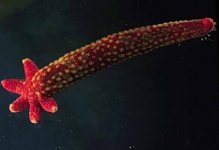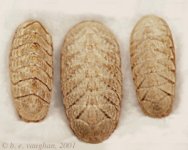After doing some work on my tank's flow rate (I have a Perfecto 75 gallon Jetstream, a topic will be appearing in the General forum shortly on this if you want to know more) and wound up having to move a lot of rock.
Along the way, I discovered ( 8O 8O 8O ) that there is a (possibly multiple) chiton (pronounced KY-ton or CHY-ton ???) in my tank. I haven't a clue where the beastie came from--but whatever the case--it's in there.
Here's where things get a little weird. My particular chiton looks relatively similar to other pictures I have seen of chitons, no big deal, right? Well, this little guy doesn't seem to have the girdle that the others (though it could have been camoflaged (spelling??)) do AND it COLOR MORPHS!!!! 8O 8O 8O like a cuttle fish or a chameleon. It did, I swear it did! It was on the underside of a piece of rock, which was kind of pinkish, it crawled up the rock and came to a green patch, where the buggy turned green, then over a piece of brownish rock and it turned brownish! I know, I saw it do it, I have a 3 year old for a witness! :lol: :lol: :lol: It eventually disappeared into the sand bed, which being whiteish (or at least USED to be), it (you guessed it) turned whiteish, aka the color of the sand. Very bizarre thing indeed.
In all the articles I have read thus far (it's really not all that many, so don't be overly impressed just yet), none of them mention color morphing.
I said all that crapola above to ask this: Is this a known behavior for chitons or do I have "sumpin' " other than a chiton? If it is a chiton, any guess on what one? A vague descrition: it looks like a cross between a trilobite and a pillbug. Can't really tell ya what color it was, because the color changed! It did seem to have sever diamond (possibly) shaped lines on its back; moved rather slow (like chitons do).
Does Mr. Brandt have a comment or suggestion per chance? :lol: Or possibly SeaMaiden? Or anyonelese for that matter (Jon and SeaMaiden seem to be the best at "Name That Bug"! :lol: :lol: :lol: )
Thanks for any input, it's greatly appreciated. I will try and hunt down that little bugger and see if I can get a picture of it.
BTW, anyone know how to get the thing off the rock wihout hurting it? (This is not one of those "Pinch Your Puffer" questions 8O :lol: ) So I can get it into something that I can photograph it in?
:lol: ) So I can get it into something that I can photograph it in?
Along the way, I discovered ( 8O 8O 8O ) that there is a (possibly multiple) chiton (pronounced KY-ton or CHY-ton ???) in my tank. I haven't a clue where the beastie came from--but whatever the case--it's in there.
Here's where things get a little weird. My particular chiton looks relatively similar to other pictures I have seen of chitons, no big deal, right? Well, this little guy doesn't seem to have the girdle that the others (though it could have been camoflaged (spelling??)) do AND it COLOR MORPHS!!!! 8O 8O 8O like a cuttle fish or a chameleon. It did, I swear it did! It was on the underside of a piece of rock, which was kind of pinkish, it crawled up the rock and came to a green patch, where the buggy turned green, then over a piece of brownish rock and it turned brownish! I know, I saw it do it, I have a 3 year old for a witness! :lol: :lol: :lol: It eventually disappeared into the sand bed, which being whiteish (or at least USED to be), it (you guessed it) turned whiteish, aka the color of the sand. Very bizarre thing indeed.
In all the articles I have read thus far (it's really not all that many, so don't be overly impressed just yet), none of them mention color morphing.
I said all that crapola above to ask this: Is this a known behavior for chitons or do I have "sumpin' " other than a chiton? If it is a chiton, any guess on what one? A vague descrition: it looks like a cross between a trilobite and a pillbug. Can't really tell ya what color it was, because the color changed! It did seem to have sever diamond (possibly) shaped lines on its back; moved rather slow (like chitons do).
Does Mr. Brandt have a comment or suggestion per chance? :lol: Or possibly SeaMaiden? Or anyonelese for that matter (Jon and SeaMaiden seem to be the best at "Name That Bug"! :lol: :lol: :lol: )
Thanks for any input, it's greatly appreciated. I will try and hunt down that little bugger and see if I can get a picture of it.
BTW, anyone know how to get the thing off the rock wihout hurting it? (This is not one of those "Pinch Your Puffer" questions 8O









